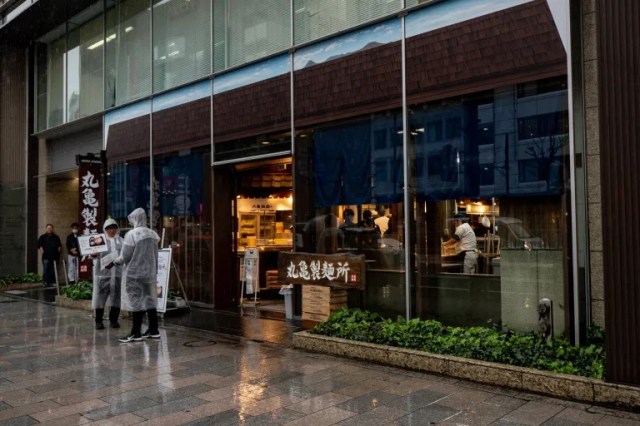
Marugame has over 800 branches in Japan, but right now this is the best one.
Rain was falling in Tokyo’s Kanda neighborhood, and our Japanese-language reporter Tasuku Egawa was hungry. While thinking of what he wanted to eat, he spotted a branch of udon noodle restaurant chain Marugame.
Wait, something was strange. The sign didn’t say 丸亀製麺, meaning “Marugame Noodles,” like it does at the chain’s regular branches. Instead, it said 丸亀製麺所, or “Marugame Noodle-making Place.”
As for what makes this branch special right now, it’s that all members of the staff are certified by Marugame as Noodle Artisans, or “Menshokunin,” as they’re called within the company.
In order to become Noodle Artisans, the employees must pass a test, proving their skills as udon specialists. Only around 30 percent of the applicants pass, which is around the same percentage that pass the entrance exam to the University of Tokyo, Japan’s most prestigious institute of higher learning.
At Marugame branches, you can spot the Noodle Artisans by their navy blue uniform collar, and sure enough, every employee in this branch has one! They’re all aces of their profession.
On the day Tasuku stopped by the restaurant, there were Noodle Artisans who’d come from Hokkaido and Hiroshima working. Watching them forming the noodles by hand, Tasuku could see that their movements were sharper and more precise than what he’s used to seeing at other Marugame branches. The Noodle Artisans seem to be on a whole other level. In technical terms, he says you could think of them as the ultimate form of Marugame noodle makers.
As of the end of February, 2024, Marugame has 838 branches in Japan. Out of all of them, this branch, with its all-Noodle Artisans, should be the most delicious of them all, so Tasuku was glad he decided to come in. After looking over the menu, he decided to order the Sanshu no Kiki Udon, which gives you three bowls of different kinds of udon for 500 yen (US$3.35).
The set includes kameage udon, where the noodles are served in a bucket-like bowl. It also has kake udon, served in a bonito stock broth, and shoyu udon, cold udon served dry with a soy sauce dip to dunk them in before each bite.
Also, since a fresh batch of tempura had just been fried up, he added three pieces to his meal.
His first photo of his food didn’t turn out too great, because of all the steam rising of the noodles and fogging up his camera lens. After wiping it off, though, the shot came out much clearer and delicious-looking.
First he tried the kameage udon.
Oh, the noodles were certainly nice and chewy, and very delicious! The noodles here aren’t shocked in cold water after cooking to tighten them up. They tasted even better than they do at regular Marugame branches, so it felt like there really is something to this all-Noodle Artisan arrangement.
Next, the kake udon.
These had a distinctly different texture from the kameage udon. Ah, it must be because they’re shocked in cold water, Tasuku thought. It really does make a big difference, he felt. It was as a big a difference to him as between eating spaghetti and linguini.
And last, he tried the shoyu udon, which is only available at select Marugame branches.
Their texture is very slippery, with a firm outer layer but chewy center! It must be because they are shocked in cold water after cooking, and still chilled when they’re served. Tasuku was newly impressed by the versatility of udon.
Because udon is a simple dish, before his meal Tasuku expected all three types of them to feel very similar. Eating them one after another in succession like this, though, the differences were far beyond what he had imagined. It was very intriguing, almost like he’d gone to an udon theme park, or had conducted a fun science experiment!
Tasuku felt very satisfied and privileged to have been able to eat udon made by a team entirely of Noodle Artisans, and had a sensation that his appreciation of udon had risen to a higher level. It had been a good meal and a good experience, and he recommends it to anyone who’s looking for a place to eat in this part of Tokyo.
Editor’s note: Tasuku either didn’t notice or was too deep in his food coma to mention, but the all-Noodle Artisan staff at this branch of Marugame is a limited-time event that runs until March 31, after which the Artisans will return to their respective regional branches.
Restaurant information
Marugame Seimen (Kanda Ogawamachi branch) / 丸亀製麺神田小川町
Address: Tokyo-to, Chiyoda-ku, Kanda Ogawamachi 3-3
東京都千代田区神田小川町3丁目3
Open 11 a.m.-9 p.m. (Monday-Thursday), 11 a.m.-8 p.m. (Friday-Saturday)
Photos © SoraNews24
● Want to hear about SoraNews24’s latest articles as soon as they’re published? Follow us on Facebook and Twitter!
[ Read in Japanese ]

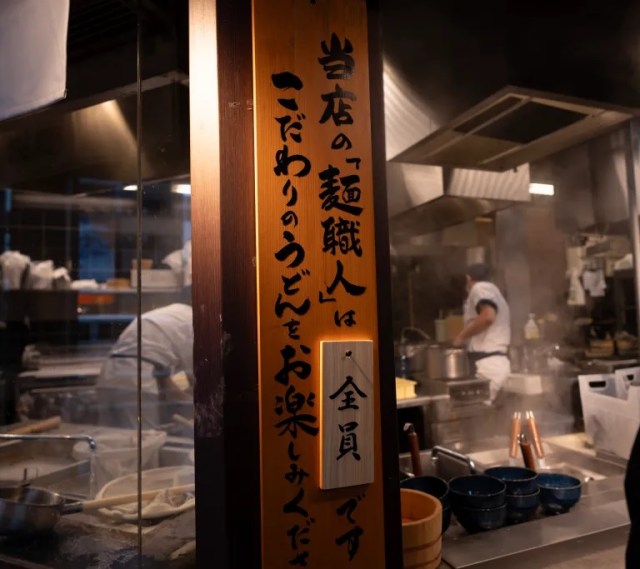
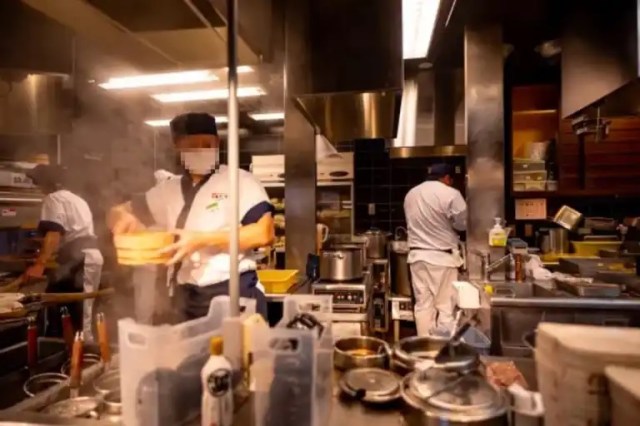
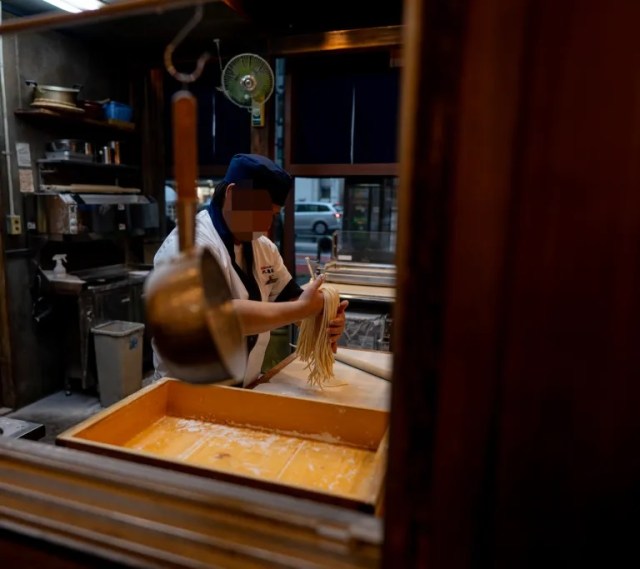
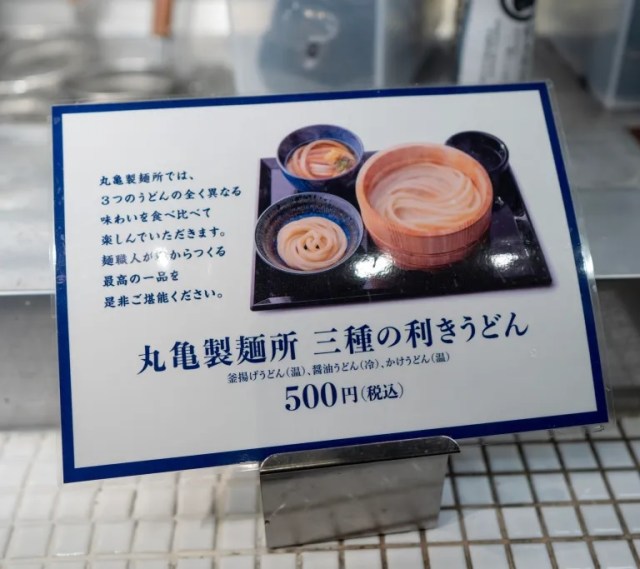
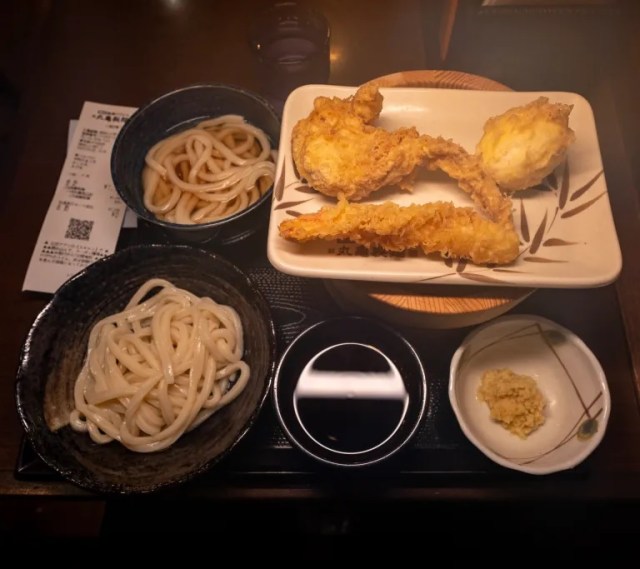
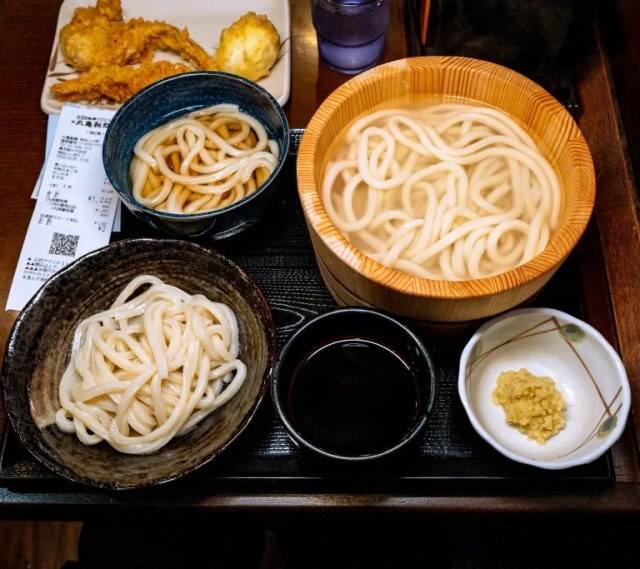
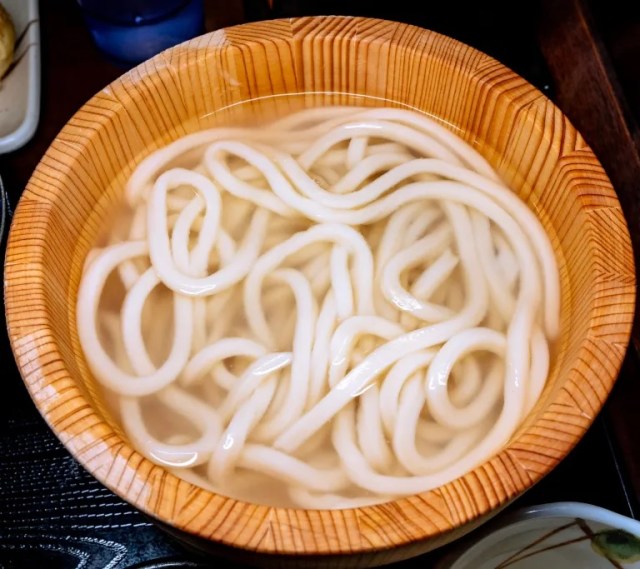
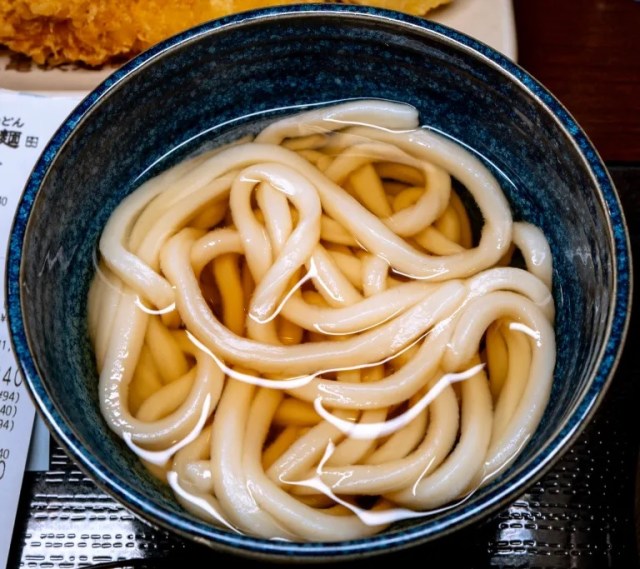
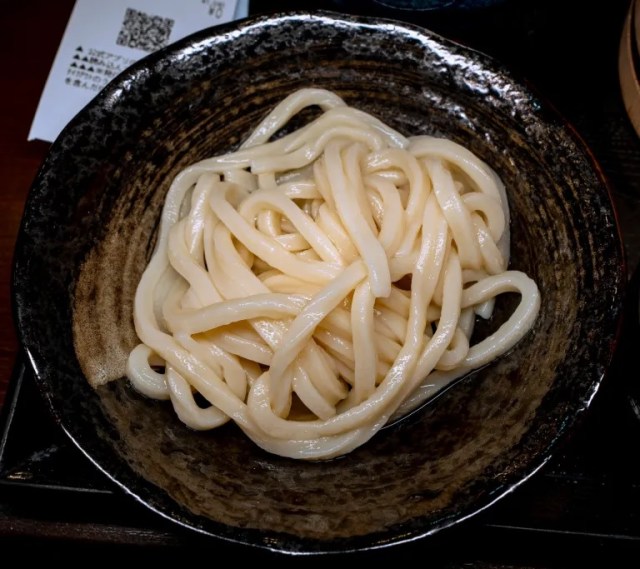
 Udonuts: Doughnuts containing udon noodles become a thing in Japan
Udonuts: Doughnuts containing udon noodles become a thing in Japan Limited-edition Carbonara Udon will anger noodle purists and pasta lovers 【Taste test】
Limited-edition Carbonara Udon will anger noodle purists and pasta lovers 【Taste test】 Popcorn shrimp udon, as in noodles with popcorn and shrimp, now on the menu in Tokyo【Taste test】
Popcorn shrimp udon, as in noodles with popcorn and shrimp, now on the menu in Tokyo【Taste test】 Noodle joint in Harajuku becomes a hot topic with foreigners on Reddit, but is it any good?
Noodle joint in Harajuku becomes a hot topic with foreigners on Reddit, but is it any good? We ate all eight kinds of cold noodles from 7-Eleven and here’s our favourites【Taste test】
We ate all eight kinds of cold noodles from 7-Eleven and here’s our favourites【Taste test】 Japan’s new difficult-to-drink-from beer glass protects your liver, but it’s a brutal experience
Japan’s new difficult-to-drink-from beer glass protects your liver, but it’s a brutal experience New Nintendo Lego kit is a beautiful piece of moving pixel art of Mario and Yoshi【Photos】
New Nintendo Lego kit is a beautiful piece of moving pixel art of Mario and Yoshi【Photos】 Come play hide-and-seek on a deserted Japanese island this August and November
Come play hide-and-seek on a deserted Japanese island this August and November To combat declining birth rate, Japan to begin offering “Breeding Visas” to foreigners
To combat declining birth rate, Japan to begin offering “Breeding Visas” to foreigners How to order snacks on a Shinkansen bullet train in Japan
How to order snacks on a Shinkansen bullet train in Japan Demon Slayer: Kimetsu no Yaiba gets new roller coaster attractions and food at Universal Studios Japan
Demon Slayer: Kimetsu no Yaiba gets new roller coaster attractions and food at Universal Studios Japan High-fashion Totoro cuddle purse is like an elegant stroll in the forest【Photos】
High-fashion Totoro cuddle purse is like an elegant stroll in the forest【Photos】 New Pokémon ice cream, dessert drinks, and cool merch coming to Baskin-Robbins Japan【Pics】
New Pokémon ice cream, dessert drinks, and cool merch coming to Baskin-Robbins Japan【Pics】 Hello, cosmetics! Clinique teams up with Hello Kitty this summer for first-time collaboration
Hello, cosmetics! Clinique teams up with Hello Kitty this summer for first-time collaboration We check out the local flavors of the commonly confused Ome and Aomi areas of Tokyo in one day
We check out the local flavors of the commonly confused Ome and Aomi areas of Tokyo in one day Nintendo history you can feel – Super NES, N64, and GameCube controllers become capsule toys
Nintendo history you can feel – Super NES, N64, and GameCube controllers become capsule toys “The most Delicious Cup Noodle in history” – Japan’s French Cup Noodle wins our heart【Taste test】
“The most Delicious Cup Noodle in history” – Japan’s French Cup Noodle wins our heart【Taste test】 Starbucks releases a cute Frappuccino and Unicorn Cake…but not in Japan
Starbucks releases a cute Frappuccino and Unicorn Cake…but not in Japan Kyoto Tower mascot termination reveals dark side behind cute Japanese characters
Kyoto Tower mascot termination reveals dark side behind cute Japanese characters McDonald’s Japan’s Soft Twist Tower: A phantom ice cream only sold at select branches
McDonald’s Japan’s Soft Twist Tower: A phantom ice cream only sold at select branches Yabai Ramen: What makes this Japanese ramen so dangerous?
Yabai Ramen: What makes this Japanese ramen so dangerous? Finally! Nintendo Japan expands Switch 8-bit controller sales to everybody, Online member or not
Finally! Nintendo Japan expands Switch 8-bit controller sales to everybody, Online member or not Japanese government wants to build luxury resorts in all national parks for foreign tourists
Japanese government wants to build luxury resorts in all national parks for foreign tourists 10 things you should buy at 7-Eleven in Japan
10 things you should buy at 7-Eleven in Japan Studio Ghibli releases anime heroine cosplay dresses that are super comfy to wear
Studio Ghibli releases anime heroine cosplay dresses that are super comfy to wear Woman charged for driving suitcase without a license in Osaka
Woman charged for driving suitcase without a license in Osaka Studio Ghibli unveils My Neighbour Totoro miniature house model
Studio Ghibli unveils My Neighbour Totoro miniature house model Kyoto experiencing problems with foreign tourists not paying for bus fares, but not on purpose
Kyoto experiencing problems with foreign tourists not paying for bus fares, but not on purpose Fighting mild hunger with a Japanese soda that turns into jelly in the stomach【Taste test】
Fighting mild hunger with a Japanese soda that turns into jelly in the stomach【Taste test】 Studio Ghibli’s Howl’s Moving Castle tapestry unveiled in Japan for first time
Studio Ghibli’s Howl’s Moving Castle tapestry unveiled in Japan for first time McDonald’s new Happy Meals offer up cute and practical Sanrio lifestyle goods
McDonald’s new Happy Meals offer up cute and practical Sanrio lifestyle goods Sales of Japan’s most convenient train ticket/shopping payment cards suspended indefinitely
Sales of Japan’s most convenient train ticket/shopping payment cards suspended indefinitely Sold-out Studio Ghibli desktop humidifiers are back so Totoro can help you through the dry season
Sold-out Studio Ghibli desktop humidifiers are back so Totoro can help you through the dry season Japanese government to make first change to romanization spelling rules since the 1950s
Japanese government to make first change to romanization spelling rules since the 1950s Foreigner’s request for help in Tokyo makes us sad for the state of society
Foreigner’s request for help in Tokyo makes us sad for the state of society Ghibli founders Toshio Suzuki and Hayao Miyazaki contribute to Japanese whisky Totoro label design
Ghibli founders Toshio Suzuki and Hayao Miyazaki contribute to Japanese whisky Totoro label design Doraemon found buried at sea as scene from 1993 anime becomes real life【Photos】
Doraemon found buried at sea as scene from 1993 anime becomes real life【Photos】 Tokyo’s most famous Starbucks is closed
Tokyo’s most famous Starbucks is closed Princesses, fruits, and blacksmiths: Study reveals the 30 most unusual family names in Japan
Princesses, fruits, and blacksmiths: Study reveals the 30 most unusual family names in Japan We tried super spicy wasabi ramen and yakisoba that’s rumored to make anyone cry【Taste Test】
We tried super spicy wasabi ramen and yakisoba that’s rumored to make anyone cry【Taste Test】 Pitch-black Black Belt udon noodles are a visual roundhouse, but do they taste good?【Taste test】
Pitch-black Black Belt udon noodles are a visual roundhouse, but do they taste good?【Taste test】 We tried eating a raw “mizu nasu” eggplant, and it tastes like a weird fruit【Taste Test】
We tried eating a raw “mizu nasu” eggplant, and it tastes like a weird fruit【Taste Test】 Reserve a spot at Michelin award-winning Waranokura for an unforgettable udon experience
Reserve a spot at Michelin award-winning Waranokura for an unforgettable udon experience Japanese woman dreams of her late grandfather eating noodles, gets a sweet surprise in the morning
Japanese woman dreams of her late grandfather eating noodles, gets a sweet surprise in the morning New Twitter trend: High school girls posing in noodle restaurants
New Twitter trend: High school girls posing in noodle restaurants We travel across the city like royalty — Hiroshima streetcar turns into fancy, private dining area
We travel across the city like royalty — Hiroshima streetcar turns into fancy, private dining area We fall in love with a bucket of Japanese custard pudding【Taste test】
We fall in love with a bucket of Japanese custard pudding【Taste test】 We learned how to make a calligraphy brush from the masters of Kumanofude in Hiroshima
We learned how to make a calligraphy brush from the masters of Kumanofude in Hiroshima Trying the peach custard treat in Japan that got over 20 thousand likes in a week
Trying the peach custard treat in Japan that got over 20 thousand likes in a week We visited Japan’s number one udon store in Gunma Prefecture
We visited Japan’s number one udon store in Gunma Prefecture Japanese convenience store’s cheap knockoff croissant — is it any good?
Japanese convenience store’s cheap knockoff croissant — is it any good? Udon chain’s awesome “Tempura Pass” deal works out to less than 10 yen per piece over five weeks
Udon chain’s awesome “Tempura Pass” deal works out to less than 10 yen per piece over five weeks Trying out First Kitchen’s tsukimi mochi burgers for a taste of Japanese autumn
Trying out First Kitchen’s tsukimi mochi burgers for a taste of Japanese autumn We try Matsuya’s beef stroganoff, only available at select spots, and learn a bit about Matsuya
We try Matsuya’s beef stroganoff, only available at select spots, and learn a bit about Matsuya Taste-testing every single sakura sweet and cherry blossom drink we could find at Mujirushi
Taste-testing every single sakura sweet and cherry blossom drink we could find at Mujirushi
Leave a Reply